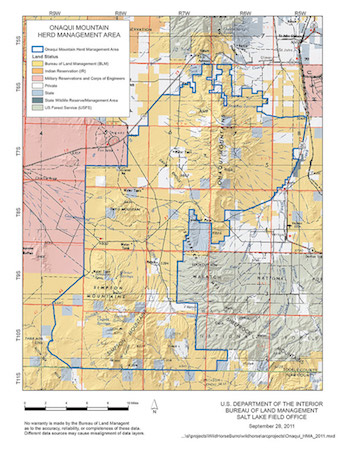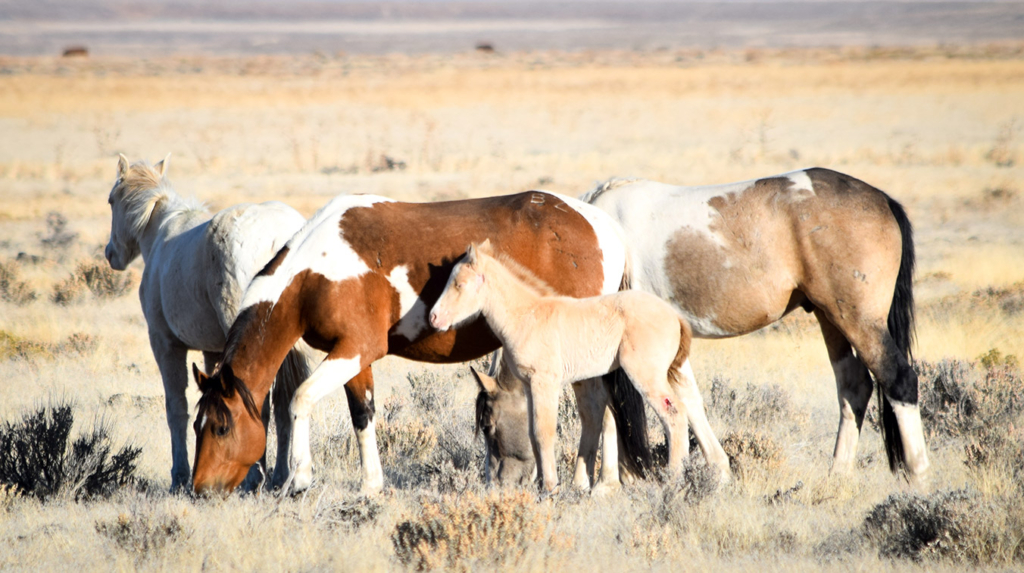Onaqui Mountain Herd
Introduction
Onaqui Mountain Herd Location
Wild Horses of America Foundation has partnered with the Bureau of Land Management (BLM) to administer contraceptives to select mares of the Onaqui Mountain Herd, which is located in the west desert of Utah. The goal of this project is to control the herd’s reproduction rate in order to minimize (and hopefully eliminate) the use of the gathers and removals that have been employed in the past to control herd size.
We feel that PZP is the best tool available right now that can effectively manage herd numbers while best preserving the horses’ natural behavior. Please visit our PZP page to learn more about this important contraceptive.
We are also working with the BLM to administer GonaCon to a select number of mares. It is being administered to some of the more difficult to dart mares, and those that are no longer living within the Herd Management Area. The goal is to see if this longer-acting contraceptive can be an effective tool in controlling the growth rate of mares that are difficult to treat annually with PZP.
Please consider making a contribution to help advance this work.
Management Area
The Onaqui Mountain Herd Management Area is located near the Dugway Proving Grounds, and is about 90 miles (by road) southwest of downtown Salt Lake City. It takes about 90 minutes to drive there on paved roads.
The two major roads within the herd area are gravel/dirt roads that are suitable for passenger cars when dry. They are usually well maintained, but do take a beating during the winter. There are also some secondary dirt roads that require high clearance and possibly four-wheel drive. (Be advised that all roads in the herd area can become difficult, or impassable, to travel after rain or snow. During one winter we know of four vehicles that had to be towed out after getting stuck in the mud.)
There are no services (food, gas, etc.) within the herd area. Please be properly prepared if you visit. Depending on your service provider, cell coverage is usually acceptable when you are north and east of Davis Mountain, but is mostly nonexistent northwest, west and south of Davis Mountain. There is also no service in the Simpson Springs area, or to the south.
To preserve the forage for the horses and other wildlife, PLEASE ONLY DRIVE ON ESTABLISHED ROADS. Not only will your tires damage the range, your tracks may encourage others to follow. The law enforcement ranger for this area will ticket violators.
Map of Herd Area

A PDF version of the ONAQUI MOUNTAIN HERD MANAGEMENT AREA
Herd Statistics
The BLM has established an Appropriate Management Level (AML) of 121-210 horses for the Onaqui herd. Currently, the BLM estimates (Spring 2023) that there are about 285 horses in the Herd Management Area.
The BLM also allows up to 2,600 cattle AUMs on the range between November and April, and thousands of sheep pass through the transit corridor that follows the Pony Express Road.
We intend to prove that the herd’s reproductive growth can be controlled through the use of contraception, and then pursue discussions about whether the Appropriate Management Level (AML) can be increased.
Herd Counts
Wild Horses of America Foundation is very concerned about maintaining at least the prescribed number of herd members. This is important for genetic viability, long-term herd sustainability, and in proving to the public and other advocacy groups that the contraceptive program is beneficial for the horses.
Wild Horses of America Foundation maintains a database for each horse that we know about, including new foals. This database is complemented and supplemented by the aerial counts that the BLM periodically conducts, and by coordination with the Onaqui Catalogue Foundation
History
The BLM has used helicopter gathers to reduce the size of the herd in the past. During the 2005, 2009 and 2012 gathers some of the gathered mares were treated with PZP-22 (a PZP variant that was designed to provide a time-release aspect that was intended to counter contraception for about 2 years) and released. There were about 50 mares in the herd who were treated this way, many of whom are still alive. You can identify them by the following brands:
All treated mares were given the BLM alpha angle neck freeze brand, and:
“BH” hip brand: Mare was treated in 2005
“1” next to the neck brand and no hip brand: Treated in 2009
“BZ” or “BH” hip brand and “3” neck brand: Treated in 2012
“BZ hip brand and “1” and “3” neck brand: Treated in 2009 and 2012
“BH hip brand and “1” and “3” neck brand: Treated all three years (5 horses fall into this category)
Here is a link to a printable page regarding PZP Brands.
The brands are unsightly on a wild animal, and we now track treated mares using pictures and physical descriptions.
While one of the side effects of PZP is that it can cause permanent sterilization in some mares, it is fairly rare, and usually only has the potential to happen after 4-5 years of consistent treatment. The majority of mares who have been treated with PZP will return to having normal fertility levels. Many of the mares on the Onaqui range, who have been treated with PZP and marked with freeze brands, have delivered healthy foals.
Here is a picture of a “PZP mare” and her foal:
The young filly (Norma Jean) in the picture was born to the branded mare (Norma, with “BZ” brand on her left hip) in November 2015. Her older brother (Norman/Frank – far left) was born in the Fall of 2014 (now deceased). Norma Jean had her first foal in the spring of 2017.

Management Plan
We suggest you read the following BLM documents pertaining to the fertility control plan for the Onaqui herd as there is a lot of good information in them:
Findings Of No Significant Impact (FONSI)
The primary goal is to reduce the reproductive rate of the herd so that helicopter gathers are not used to control herd size. Selected mares who are at least 18 months of age will be treated until they are 4 years old. Then, treatment will be suspended until each mare has produced a foal who has survived for at least one year.
The mares are being treated with ZonaStat-H which is an emulsion of PZP and an adjuvant. Each mare requires a primer and a booster for the PZP to reach peak performance. The mares who the BLM previously caught, treated and released (branded mares) only require the booster. If a mare has been treated previously (for example, the branded mares who were caught, treated and released) then only an annual booster is required.
Each dose is delivered remotely, by dart gun, and does not require that the mare be rounded-up and/or held captive.
Please consider making a donation to help support our efforts.
